Harbour (from M. E. hereberge, here, an army; cf. Ger. Heer and -beorg, protection or shelter. Other early forms in English were herberwe and harborow, as seen in various place names, such as Market Harborough. The French auberge, an inn, derived through heberger, is thus the same word), a place of refuge or shelter. It is thus used for an asylum for criminals, and particularly for a place of shelter for ships.
Sheltered sites along exposed sea-coasts are essential for purposes of trade, and very valuable as refuges for vessels from storms. In a few places, natural shelter is found in combination with ample depth, as in the Bay of Rio de Janeiro, New York Harbour (protected by Long Island), Portsmouth Harbour and Southampton Water (sheltered by the Isle of Wight), and the land-locked creeks of Milford Haven and Kiel Harbour. At various places there are large enclosed areas which have openings into the sea; but these lagoons for the most part are very shallow except in the main channels and at their outlets. Access to them is generally obstructed by a bar as at the lagoon harbour of Venice (fig. 1), and similar harbours, like those of Poole and Wexford; and such harbours usually require works to prevent their deterioration, and to increase the depth near their outlet. Generally, however, harbours are formed where shelter is provided to a certain extent by a bay, creek or projecting headland, but requires to be rendered complete by one or more breakwaters (see Breakwater), or where the approach to a river, a ship-canal or a seaport, needs protection. A refuge harbour is occasionally constructed where a long length of stormy coast, near the ordinary track of vessels, is entirely devoid of natural shelter. Naval harbours are required by maritime powers as stations for their fleets, and dockyards for construction and repairs, and also in some cases as places of shelter from the night attacks of torpedoes. Commercial harbours have to be provided for the formation of ports within their shelter on important trade routes, or for the protection of the approaches from the sea of ports near the sea-coast, or maritime waterways running inland, in some cases at points on the coast devoid of all natural shelter. A greater latitude in the selection of suitable sites is, indeed, possible for refuge and naval harbours than for commercial harbours; but these three classes of harbours are very similar in their general outline and the works protecting them, only differing in size and internal arrangements according to the purpose for which they have been constructed, the chief differences being due to the local conditions.
Harbours may be divided into three distinct groups, namely, lagoon harbours, jetty harbours and sea-coast harbours, protected by breakwaters, including refuge, naval and commercial harbours.
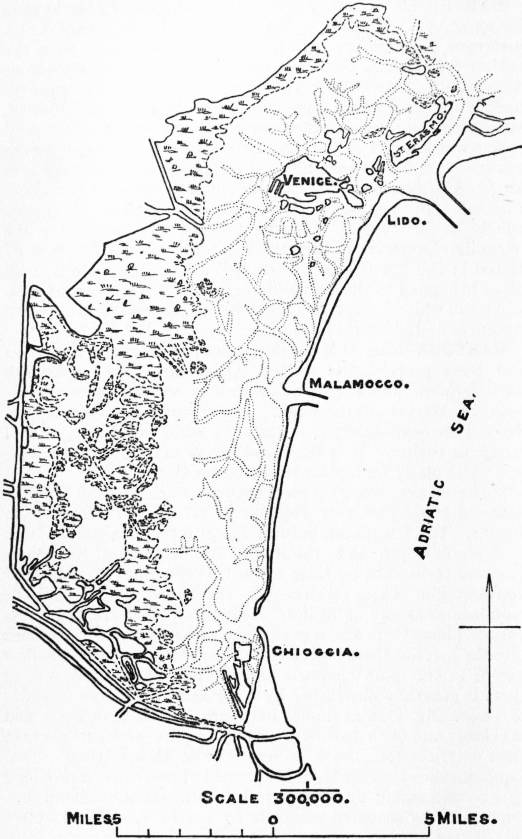 |
| Fig. 1.—Venetian Lagoon Harbour. |
Lagoon Harbours.—A lagoon, consisting of a sort of large shallow lake separated from the sea by a narrow belt of coast, formed of deposit from a deltaic river or of sand dunes heaped up by on-shore winds along a sandy shore, possesses good natural shelter; and, owing to the large expanse which is filled and emptied at each tide, even when the tidal range is quite small, together with the discharge from any rivers flowing into the lagoon, one or more fairly deep outlets are maintained through the fringe of coast, which afford navigable access to the lagoon; whilst channels formed inside by the currents lead to ports on its banks. Lagoons, however, are liable to be gradually silted up, if rivers flowing into them bring down considerable quantities of alluvium, which is readily deposited in their fairly still waters; and their outlet channels are in danger of becoming shallower, by the sea in storms forming additional outlets by breaking through the narrow barrier separating them from the sea. Moreover, the approach from the sea to these channels through the fringe of coast is generally impeded by a bar, owing to the scour of the issuing current through these outlet channels becoming gradually too enfeebled, on entering the open sea, to overcome the heaping-up action of the waves along the shore, which tends to form a continuous beach across these openings. Rivers, accordingly, whose discharge is very valuable in maintaining a lagoon if their waters are free from sediment, must, if possible, be diverted from a lagoon if they bring down large amounts of silt; whilst the narrow belt of land in front of the lagoon must be protected from erosion by the waves, on its sea face, by groynes or revetments. The depth over the bar in front of an outlet can be improved by concentrating the current through the outlet by jetties on each side, and prolonging the jetties, and consequently the scour, out to the bar so as to lower it, and by supplementing the scouring action, if necessary, by dredging.
Jetty Harbours.—Several small ports were formed on the sea-coast long ago at points where flat marshy ground lying below the level of high-water, and shut off from the sandy beach by dikes or sand dunes, was connected with the sea by a small creek or river. Such ports presented in their original condition a slight resemblance to lagoons on a very small scale. Several examples are to be found on the sandy shores of the English Channel and North Sea, such as Dieppe, Boulogne, Calais, Dunkirk, Nieuport and Ostend, where the influx and efflux of the water from these enclosed tide-covered areas, through a narrow opening, sufficed to maintain a shallow channel to the sea across the beach, deep enough near high-water for vessels of small draught. When the increase in draught necessitated the provision of an improved channel, the scour of the issuing current was concentrated and prolonged by erecting parallel jetties across the beach, raised solid to a little above low water of neap tides, with open timber-work above to indicate the channel and guide the vessels. Even this low obstruction, however, to the littoral drift of sand caused an advance of the low water line as the jetties were carried out, so that further extensions of the jetties had eventually to be abandoned, as occurred at Dunkirk (see Dock). Moreover, reclamation of the low-lying areas was gradually effected, thus reducing the tidal scour; and sluicing basins were excavated in part of the low ground, into which the tide flowed through the entrance channel, and the water being shut in at high tide by gates at the outlet of the basin, was released at low water, producing a rapid current through the channel as a compensation for the loss of the former natural scour. The current, however, from the sluicing basin gradually lost its velocity in passing down the channel, and besides, being most effective near the outlet of the basin, could only scour the channel down to a moderate depth below low water, on account of the increase in the volume of still water in the channel at low tide as its deepening progressed. Lastly, about 1880, improvements in suction dredgers (see Dredge and Dredging) led to the adoption of sand-pump dredging in the outer part of the channel, and across the foreshore in front to deep water; and at Dunkirk, docks were formed on the site of the sluicing basin; whilst at Calais sluicing was abandoned in favour of dredging. Ostend is the only jetty harbour in which a large sluicing basin has been recently constructed, but it can only provide for the maintenance of deep-water quays in its vicinity; and dredging is relied upon to an increasing extent, both for the maintenance and further deepening of the outer portion of the approach channel, and for maintaining the direct channel dredged to deep water across the Stroombank extending in front of Ostend (fig. 2).
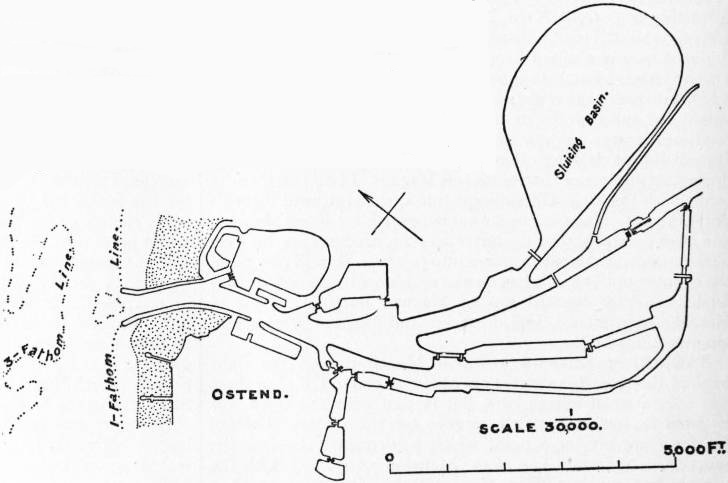 |
| Fig. 2.—Ostend Harbour and Jetty Channel. |
Similar methods of improving the entrance channel to ports possessing an extensive backwater have been adopted on a large scale in the United States. For instance at Charleston, converging jetties, about 2¾ m. long, have been extended across the bar to concentrate the scour due to a small tidal range expanding over the enclosed backwater, 15 sq. m. in extent, and to protect the channel from littoral drift; but these jetties have caused an advance of the foreshore, and a progression seawards of the bar, necessitating dredging beyond the ends of the jetties to maintain the requisite depth.
Parallel jetties, moreover, across the beach, combined with extensive sand-pump dredging, have been employed with success at some of the ports situated at the outlet of rivers, enclosed bays, or lagoons, on the sandy shores of south-east Africa, for improving the access to them across encumbering shoals, where the littoral drift is too great to allow of the projection of breakwaters from the shore to shelter an approach channel.
Harbours Protected by Breakwaters.—The design for a harbour on the sea-coast must depend on the configuration of the adjacent coast-line, the extent and direction of the exposure, the amount of sheltered area required and the depth obtainable, the prospect of the accumulation of drift or the occurrence of scour from the proposed works, and the best position for an entrance in respect of shelter and depth of approach.
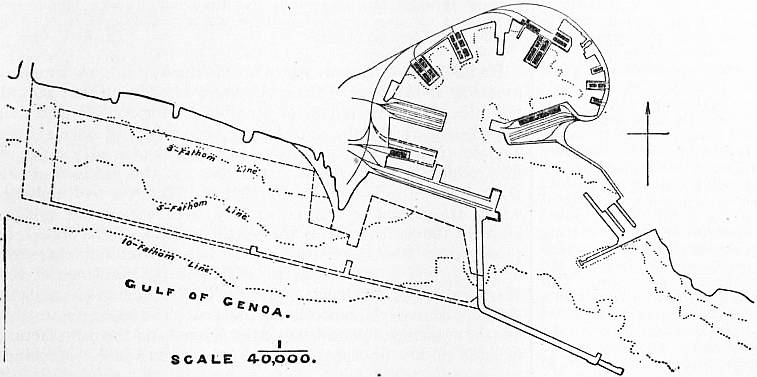 |
| Fig. 3.—Genoa Harbour and Extensions. |
Completion of Shelter of Harbours in Bays.—In the case of a deep, fairly land-locked bay, a detached breakwater across the outlet completes the necessary shelter, leaving an entrance between each extremity and the shore, provided there is deep enough water near the shore, as effected at Plymouth harbour, and also across the wider but shallower bay forming Cherbourg harbour. A breakwater may instead be extended across the outlet from each shore, leaving a single central entrance between the ends of the breakwaters; and if one breakwater placed somewhat farther out is made to overlap an inner one, a more sheltered entrance is obtained. This arrangement has been adopted at the existing Genoa harbour within the bay (fig. 3), and for the harbour at the mouth of the Nervion (see River Engineering). The adoption of a bay with deep water for a harbour does not merely reduce the shelter to be provided artificially, but it also secures a site not exposed to silting up, and where the sheltering works do not interfere with any littoral drift along the open coast. A third method of sheltering a deep bay is that adopted for forming a refuge harbour at Peterhead (fig. 4), where a single breakwater is extended out from one shore for 3250 ft. across the outlet of the bay, leaving a single entrance between its extremity and the opposite shore and enclosing an area of about 250 acres at low tide, half of which has a depth of over 5 fathoms.
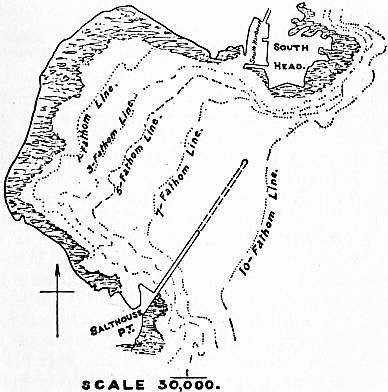 |
| Fig. 4.—Peterhead Harbour of Refuge. |
Harbours possessing partial Natural Shelter.—The most common form of harbour is that in which one or more breakwaters supplement a certain amount of natural shelter. Sometimes, where the exposure is from one direction only, approximately parallel with the coast-line at the site, and there is more or less shelter from a projecting headland or a curve of the coast in the opposite direction, a single breakwater extending out at right angles to the shore, with a slight curve or bend inwards near its outer end, suffices to afford the necessary shelter. As examples of this form of harbour construction may be mentioned Newhaven breakwater, protecting the approach to the port from the west, and somewhat sheltered from the moderate easterly storms by Beachy Head, and Table Bay breakwater, which shelters the harbour from the north-east, and is somewhat protected on the opposite side by the wide sweep of the coast-line known as Table Bay. Generally, however, some partial embayment, or abrupt projection from the coast, is utilized as providing shelter from one quarter, which is completed by breakwaters enclosing the site, of which Dover and Colombo (fig. 5) harbours furnish typical and somewhat similar examples.
 |
| Fig. 5.—Colombo Harbour. |
Harbours formed on quite Open Seacoasts.—Occasionally harbours have to be constructed for some special purpose where no natural shelter exists, and where on an open, sandy shore considerable littoral drift may occur. Breakwaters, carried out from the shore at some distance apart, and converging to a central entrance of suitable width, provide the requisite shelter, as for instance the harbour constructed to form a sheltered approach to the river Wear and the Sunderland docks (fig. 6). If there is little littoral drift from the most exposed quarter, the amount of sand brought in during storms, which is smaller in proportion to the depth into which the entrance is carried, can be readily removed by dredging; whilst the scour across the projecting ends of the breakwaters tends to keep the outlet free from deposit. Where there is littoral drift in both directions on an open, sandy coast, due to winds blowing alternately from opposite quarters, sand accumulates in the sheltered angles outside the harbour between each converging breakwater and the shore. This has happened at Ymuiden harbour at the entrance to the Amsterdam ship-canal on the North Sea, but there the advance of the shore appears to have reached its limit only a short distance out from the old shore-line on each side; and the only evidence of drift consists in the advance seawards of the lines of soundings alongside, and in the considerable amount of sand which enters the harbour and has to be removed by dredging. The worst results occur where the littoral drift is almost wholly in one direction, so that the projection of a solid breakwater out from the shore causes a very large accretion on the side facing the exposed quarter; whilst owing to the arrest of the travel of sand, erosion of the beach occurs beyond the second breakwater enclosing the harbour on its comparatively sheltered side. These effects have been produced at Port Said harbour at the entrance to the Suez Canal from the Mediterranean, formed by two converging breakwaters, where, owing to the prevalent north-westerly winds, the drift is from west to east, and is augmented by the alluvium issuing from the Nile. Accordingly, the shore has advanced considerably against the outer face of the western breakwater; and erosion of the beach has occurred at the shore end of the eastern breakwater, cutting it off from the land. The advance of the shore-line, however, has been much slower during recent years; and though the progress seawards of the lines of soundings close to and in front of the harbour continues, the advance is checked by the sand and silt coming from the west passing through some apertures purposely left in the western breakwater, and falling into the approach channel, from which it is readily dredged and taken away. Madras harbour, begun in 1875, consists of two breakwaters, 3000 ft. apart, carried straight out to sea at right angles to the shore for 3000 ft., and completed by two return arms inclined slightly seawards, enclosing an area of 220 acres and leaving a central entrance, 550 ft. wide, facing the Indian Ocean in a depth of about 8 fathoms. The great drift, however, of sand along the coast from south to north soon produced an advance of the shore against the outside of the south breakwater, and erosion beyond the north breakwater; and the progression of the foreshore has extended so far seawards as to produce shoaling at the entrance. Accordingly, the closing of the entrance, and the formation of a new entrance through the outer part of the main north breakwater, facing north and sheltered by an arm starting from the angle of the northern return arm and running north parallel to the shore, round the end of which vessels would turn to enter, have been recommended, to provide a deep entrance beyond the influence of the advancing foreshore.
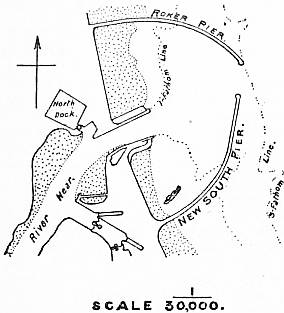 |
| Fig. 6.—Sunderland Harbour. |
Proposals have been made from time to time to evade this advance of the foreshore against a solid obstacle, by extending an open viaduct across the zone of littoral drift, and forming a closed harbour, or a sheltering breakwater against which vessels can lie, beyond the influence of accretion. This principle was carried out on a large scale at the port of call and sheltering breakwater constructed in front of the entrance to the Bruges ship-canal, at Zeebrugge on the sandy North Sea coast, where a solid breakwater, provided with a wide quay furnished with sidings and sheds, and curving round so as to overlap thoroughly the entrance to the canal and shelter a certain water-area, is approached by an open metal viaduct extending out 1007 ft. from low water into a depth of 20 ft. (fig. 7). It is hoped that by thus avoiding interference with the littoral drift close to the shore, coming mainly from the west, the accumulation of silt to the west of the harbour, and also in the harbour itself, will be prevented; and though it appears probable that some accretion will occur within the area sheltered by the breakwater, it will to some extent be disturbed by the wash of the steamers approaching and leaving the quays, and can readily be removed under shelter by dredging.
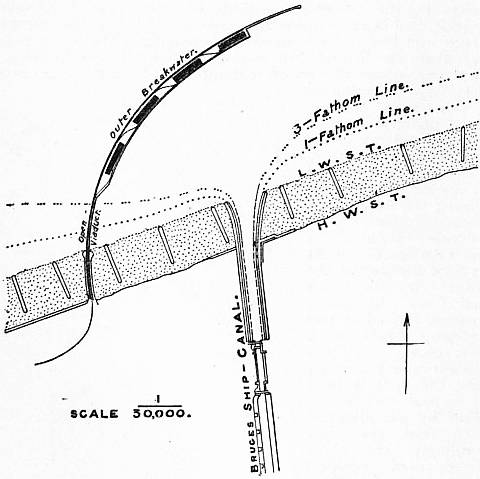 |
| Fig. 7.—Zeebrugge Harbour. |
Entrances to Harbours.—Though captains of vessels always wish for wide entrances to harbours as affording greater facility of safe access, it is important to keep the width as narrow as practicable, consistent with easy access, to exclude waves and swell as much as possible and secure tranquillity inside. At Madras, the width of 550 ft. proved excessive for the great exposure of the entrance, and moderate size of the harbour, which does not allow of the adequate expansion of the entering swell. Where an adequately easy and safe approach can be secured, it is advantageous to make the entrance face a somewhat sheltered quarter by the overlapping of the end of one of the breakwaters, as accomplished at Bilbao and Genoa harbours (fig. 3), and at the southern entrance to Dover harbour. Occasionally, owing to the comparative shelter afforded by a bend in the adjacent coast-line, a very wide entrance can be left between a breakwater and the shore; typical examples are furnished by the former open northern entrance to Portland harbour, now closed against torpedoes, and the wide entrances at Holyhead and Zeebrugge (fig. 7). With a large harbour and the adoption of a detached breakwater, it is possible to gain the advantage of two entrances facing different quarters, as effected at Dover and Colombo, which enables vessels to select their entrance according to the state of the wind and weather; where there is a large tidal rise they reduce the current through the entrances, and they may, under favourable conditions, create a circulation of the water in the harbour, tending to check the deposit of silt.


